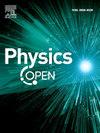掺杂类金属元素的五边形Pt2Se4单层的电子、磁性和光学性质
IF 1.4
Q2 Physics and Astronomy
引用次数: 0
摘要
利用密度泛函理论研究了掺杂类金属元素(B、Si、Ge、As、Sb、Te和At)代替Pt和Se原子的五边形Pt2Se4单层的电子、磁性和光学性质。我们对形成能的计算表明,对于所有的类金属来说,Se位点的掺杂在能量上是优先的,pt位点的取代始终表现出更高的形成能,平均比相应的Se位点的取代高约2.0 eV。除As在体系中产生约0.5 μB的磁矩外,其余掺杂剂均保持体系的非磁性。as -pz轨道的上下自旋分裂可以被认为是磁矩出现的主要原因,这一现象在其他掺杂构型中是不存在的。除了B和Sb掺杂剂,其中新的杂质态与费米能级相交,其余的掺杂系统保持半导体性质。所有掺杂体系在可见能量范围内表现出接近透明的行为。然而,对于掺杂B和at的系统,入射光在红外区域被有效抑制。掺入As、At、B、Ge、Sb、Te和Si的Pt2Se4的静态介电常数ϵ1(0)分别为1.08、1.76、1、1.17、1和1。这些不同的发现为自旋电子学、光电子学和光学纳米结构的发展带来了希望。本文章由计算机程序翻译,如有差异,请以英文原文为准。
Electronic, magnetic, and optical properties of pentagonal Pt2Se4 monolayer doped with metalloid elements
The electronic, magnetic, and optical properties of the pentagonal Pt2Se4 monolayer doped with metalloid elements (B, Si, Ge, As, Sb, Te, and At) as substitutes for Pt and Se atoms were explored using density functional theory. Our calculations of formation energies indicate that doping at the Se site is energetically preferred for all metalloids, with the Pt-site substitutions consistently exhibiting higher formation energies, averaging approximately 2.0 eV higher than the corresponding Se-site substitutions. Except for As, which induces a magnetic moment of approximately 0.5 μB in the system, the other dopants maintain the system's non-magnetic characteristics. The up-and-down-spin splitting of the As-pz orbital can be regarded as the primary reason for the emergence of the magnetic moment, a phenomenon absent in the other doped configurations. Apart from the B and Sb dopants, where new impurity states intersect the Fermi energy level, the remaining doped systems maintain semiconductor properties. All doped systems exhibit nearly transparent behavior in the visible energy range. However, incident light is effectively inhibited in the infrared region for B- and At-doped systems. The static dielectric constants ϵ1(0) for Pt2Se4 doped with As, At, B, Ge, Sb, Te, and Si are reported as 1.08, 1.76, 1, 1.17, 1, and 1, respectively. These varied findings hold promise for applications in spintronics, optoelectronics, and the advancement of optical nanostructures.
求助全文
通过发布文献求助,成功后即可免费获取论文全文。
去求助
来源期刊

Physics Open
Physics and Astronomy-Physics and Astronomy (all)
CiteScore
3.20
自引率
0.00%
发文量
19
审稿时长
9 weeks
 求助内容:
求助内容: 应助结果提醒方式:
应助结果提醒方式:


